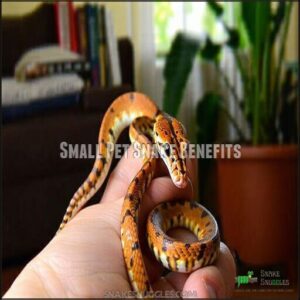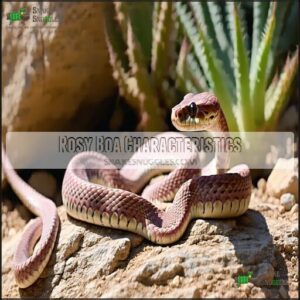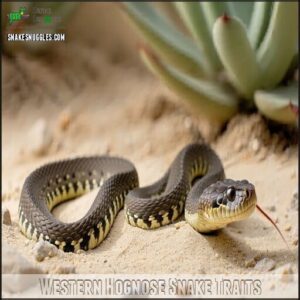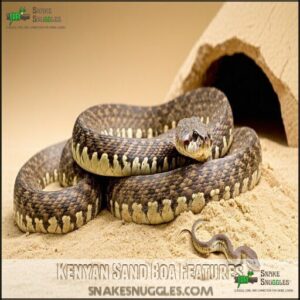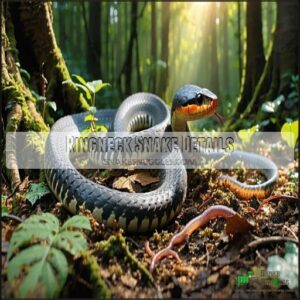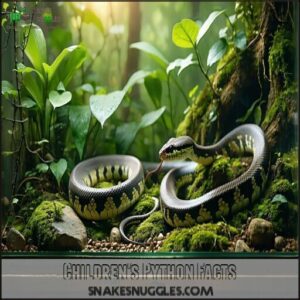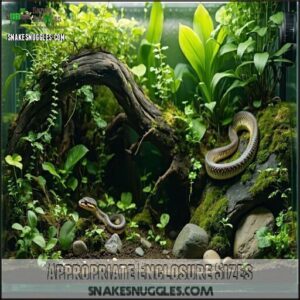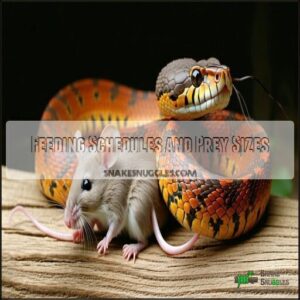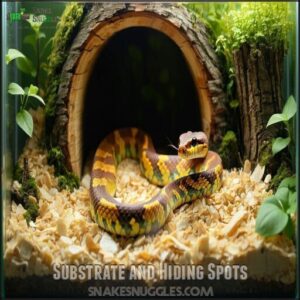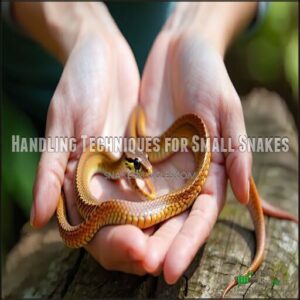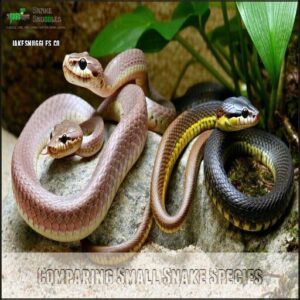This site is supported by our readers. We may earn a commission, at no cost to you, if you purchase through links.
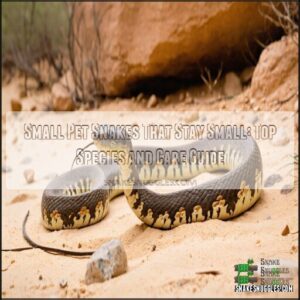 If you’re looking for small pet snakes that stay small, consider options like Rosy Boas, Western Hognose Snakes, or Kenyan Sand Boas.
If you’re looking for small pet snakes that stay small, consider options like Rosy Boas, Western Hognose Snakes, or Kenyan Sand Boas.
These species are perfect for beginners—they’re low-maintenance, require small enclosures, and are easy to handle.
For example, a Western Hognose only grows to about 2-3 feet, and their quirky upturned noses add plenty of charm.
Kenyan Sand Boas are even shorter, usually staying under 2 feet and loving to burrow, which is endlessly entertaining.
Snakes like these are safe, manageable, and fascinating.
Just remember, a little research goes a long way to keeping both you and your snake happy!
Table Of Contents
- Key Takeaways
- Small Pet Snake Benefits
- Top Small Pet Snakes
- Small Snake Care Requirements
- Comparing Small Snake Species
- Choosing Small Pet Snakes
- Frequently Asked Questions (FAQs)
- What is the most cuddly pet snake?
- What small snake is a good pet?
- What pet snakes stay the smallest?
- What is the most low maintenance snake?
- What small snakes like to be handled?
- What is the smallest non poisonous snake in the world?
- How long do small pet snakes typically live?
- Are small snakes suitable for handling by children?
- Can small snakes be kept together in one enclosure?
- What are the best small snakes for apartments?
- Conclusion
Key Takeaways
- You can choose small, beginner-friendly snakes like Kenyan Sand Boas, Western Hognose Snakes, or Rosy Boas for easy care and handling.
- Small snakes thrive in compact, low-cost enclosures, making them perfect for apartments and smaller living spaces.
- Feeding is affordable and simple, with frozen prey being safer and easier to manage than live feeding.
- These snakes are hypoallergenic, docile, and safe, making them great companions even for kids.
Small Pet Snake Benefits
Small pet snakes offer plenty of perks, especially for first-time reptile owners. They’re easy to care for, budget-friendly, and fit perfectly into smaller living spaces.
Perfect for beginners, small pet snakes bring easy care, affordability, and space-saving charm to any reptile-loving household!
Low-Cost Maintenance
Why are small pet snakes so budget-friendly? Their feeding frequency is low, and snake diets rely on affordable frozen prey.
Their low-maintenance nature, such as low-maintenance snakes like corn snakes, thrive in basic enclosures.
Habitat upkeep is simple, with minimal heating alternatives and DIY enrichment keeping costs down. Veterinary costs are rare, making pet snake maintenance a wallet-friendly choice for beginners, due to the rare veterinary costs.
No Danger of Injury
With small pet snakes, you won’t worry about bite force or venom potency.
Small pet snakes are safe, gentle, and perfect for beginners—no strong bites, no venom worries, just calm and fascinating companions!
These docile species are perfect for handling safety, especially around kids.
Many beginner snakes, like:
- Corn snakes: Small nonvenomous snakes with calm temperaments.
- Rosy boas: Child-friendly snakes that rarely strike.
- Kenyan sand boas: Gentle, easy-to-handle companions.
Snake bite risk? Practically non-existent!
To guarantee their well-being, monitor their temperature and humidity carefully.
No Allergies
Unlike furry pets, snakes are a hairless, allergy-friendly option.
With no dander exposure or shedding concerns, they’re ideal if you’ve got allergies.
Snake allergens, like protein irritants from saliva, are rare and manageable with simple handling precautions.
Plus, as a clean, furless pet, a snake offers a low-maintenance, sneeze-free companion that’s perfect for those seeking a hypoallergenic household addition.
Space-Saving Enclosures
A snake enclosure doesn’t need to dominate your room. Small pet snakes thrive in compact spaces, making terrarium size manageable.
- Vertical enclosures suit climbing species.
- Bioactive setups add flair while mimicking nature.
- DIY terrariums let you customize on a budget.
- Collapsible enclosures are perfect for portability.
With a minimalist design, your snake habitat can be stylish and space-saving!
Lower Feeding Costs
Smaller snakes mean smaller prey, which keeps snake feeding costs low.
Frozen rodents are easy to store and cheaper than live prey, plus safer for your snake.
Feeding frequency is manageable, often just once a week, and breeding feeders at home can save even more.
With small pet snakes, affordable snake food options make ownership budget-friendly without cutting corners on care, and this is a key factor in making snake ownership budget-friendly.
Top Small Pet Snakes
If you’re looking for snakes that stay small and are easy to manage, you’ve got plenty of great options.
These species are perfect for beginners and experienced keepers alike, thanks to their manageable size and calm temperaments.
Rosy Boa Characteristics
If you’re exploring small snake breeds, the rosy boa stands out.
With size variations from 17 to 44 inches, its calm temperament traits make it perfect for beginners.
Habitat needs are simple—rocky, dry setups mimic their natural environment.
Feeding habits are easy, as they thrive on frozen mice.
With a lifespan factor of up to 25 years, it’s a loyal companion.
Western Hognose Snake Traits
The Western Hognose is one of the best small snakes for beginners, blending charm with manageable care.
Its playful bluffing antics, like hissing or "playing dead," make it stand out.
This small snake breed thrives with easy housing needs and tons of morph variations.
- Docile temperament.
- Venom potency is mild but harmless to most.
- Snake size maxes out under 3 feet, which is a key factor in its manageable care and overall charm.
Kenyan Sand Boa Features
The Kenyan Sand Boa is a fantastic choice for small snakes for beginners.
Known for their compact snake size and burrowing behavior, they’re low-maintenance pets with docile temperaments.
Their Sand Boa Morphs add variety to their already charming appeal.
With manageable feeding habits and simple enclosure preferences, they thrive in sandy substrates and tight hides, making them easy-to-care-for, fascinating companions with a docile temperament.
Ringneck Snake Details
Ringneck snakes are a charming choice among small snake species, staying just 8–16 inches long.
Their striking orange-ringed neck and morph variations make them visually unique.
They thrive in forested habitats and have simple care needs.
- Diet: Earthworms, slugs, and small insects.
- Lifespan: Typically stable populations.
- Suitability: Perfect for low-maintenance snake care.
Children’s Python Facts
Children’s Pythons, part of the Antaresia Pythons group, are tiny stars within small snake species.
Reaching an adult size of just 3 feet, their temperament evolves from snappy to calm with handling.
Low-maintenance feeding habits—every two weeks—make them a standout among python breeds, with benefits including enclosure enrichment and the ability to enjoy their charming morph variations.
A perfect pet snake recommendation!
Small Snake Care Requirements
Caring for small snakes isn’t as tricky as it might seem, but it does require attention to their specific needs.
From providing a cozy enclosure to managing feeding schedules, getting the details right keeps your pet healthy and stress-free.
Appropriate Enclosure Sizes
When setting up snake enclosures, size matters. A proper snake terrarium setup guarantees comfort and safety.
For small pet snakes:
- Use tanks like 20–30 gallons, adjusting tank dimensions for adult size.
- Provide 2–4 inches of substrate depth for burrowing.
- Add hiding spaces and enrichment needs like branches or rocks.
Consider terrarium product options for ideal design. Your snake’s happiness depends on a well-thought-out snake tank setup!
Temperature and Humidity Control
Keeping your snake comfy means nailing the right temperature and humidity.
Use heating gradients—warm on one side, cooler on the other—to meet their specific temperature needs.
Monitor humidity levels with proper equipment, especially during shedding assistance.
Heating pads are essential for maintaining these temperatures.
Seasonal adjustments may be needed, so tweak temperature control as required to ensure happy, healthy reptiles!
Reliable monitoring guarantees proper humidity regulation.
Feeding Schedules and Prey Sizes
Feeding schedules depend on your snake’s size and age.
Hatchlings often eat every 4-5 days, while adults need meals weekly or bi-weekly.
Always match the prey item size to your snake’s widest point.
Frozen rodents are safer than live prey and prevent injuries.
Consistent feeding habits and monitoring your snake’s response help maintain healthy growth and proper snake size management.
Substrate and Hiding Spots
Your snake’s habitat needs the right substrate types and plenty of hiding spots.
Snake substrate like aspen shavings works well for burrowing behavior, while coconut fiber helps with humidity retention.
Add a snake hide box for security—think of it as their cozy little fort.
Clean substrate regularly; tidy homes mean happy snakes who feel safe and comfortable!
Many owners buy snake aspen shavings for their pets.
Handling Techniques for Small Snakes
Once your snake has cozy hiding spots, handling becomes key.
Always use safe grips to avoid injury, and don’t squeeze tightly—imagine holding a ripe banana.
Start with brief sessions to reduce stress and increase handling frequency as trust builds.
Recognize signs like hissing or coiling tightly as discomfort.
Avoid sudden movements to prevent startling the snake.
Snake handling tips: stay calm, move slow, prevent bites gently, and remember to handle with care.
Comparing Small Snake Species
When choosing a small pet snake, comparing species helps you find one that fits your lifestyle and experience.
Each snake has unique traits, from size to temperament, making it important to weigh your options carefully.
Rosy Boa Vs. Western Hognose
When comparing the Rosy Boa and Western Hognose, both shine as beginner-friendly small snake species.
The Rosy Boa’s gentle temperament and low enclosure needs contrast with the Western Hognose’s quirky bluffing behaviors and mild venom potency.
Feeding habits differ too—Rosy Boas adapt well to thawed prey, while the Hognose thrives on variety.
Morph availability for both is abundant!
Kenyan Sand Boa Vs. Children’s Python
When choosing between a Kenyan sand boa and a Children’s python, consider these key differences:
- Size comparison: Sand boas max out at 3 feet, while Children’s pythons reach about 4 feet.
- Temperament traits: Sand boas are shy; pythons become calmer with handling.
- Feeding differences: Both adapt to frozen prey.
- Enclosure needs: Each thrives in small setups.
- Beginner suitability: Both are excellent pet snake recommendations.
Ringneck Snake Vs. Rough Green Snake
How do Ringneck Snakes and Rough Green Snakes stack up? Let’s break it down:
| Feature | Ringneck Snake | Rough Green Snake |
|---|---|---|
| Habitat comparison | Terrestrial, fossorial | Arboreal, near waterways |
| Diet differences | Salamanders, slugs, worms | Insects, spiders |
| Conservation status | Abundant | Endangered in some areas |
Ringneck Snakes are nocturnal with mild venom, while Rough Greens are diurnal and arboreal.
Their vibrant coloration provides excellent camouflage in their natural habitats.
Both charming—yet uniquely different, with Ringneck Snakes and Rough Green Snakes exhibiting distinct characteristics that set them apart, including their habitat and diet.
Temperament and Handling Differences
In terms of temperament, younger snakes can be more unpredictable, while older ones tend to calm down.
Docile snakes like the Rosy Boa are fantastic for regular handling, whereas flighty species, such as Kenyan Sand Boas, need patience.
Captive breeding improves snake temperament overall. Handling frequency matters too—gentle, routine interactions boost trust and prevent stressful encounters, ensuring snake handling safety.
Lifespan and Long-term Commitment
When planning for a snake’s lifespan, remember species like Rosy Boas may live over 25 years, while smaller species like Western Hognoses average 15-20.
Snake longevity depends on care, genetics, and health. Factor in unexpected illnesses and end-of-life care.
Captive snakes often live longer due to consistent care. Legacy planning matters too—who’ll care for it later?
Meeting each snake’s life needs guarantees years of companionship!
Choosing Small Pet Snakes
When choosing a small pet snake, focus on finding a species that matches your experience level, lifestyle, and space.
Make sure to research reputable breeders and understand the long-term care they’ll need.
Assessing Your Experience Level
Before selecting small pet snakes, think about your experience. Beginner-friendly snakes suit those learning the ropes.
Ask yourself:
- How often will you handle the snake?
- Do you know about feeding experience and prey sizes?
- Can you maintain the enclosure correctly?
- Have you researched snake breeds for beginners?
- What snake temperament fits your comfort level?
Pick a match for your skills!
Considering Your Lifestyle and Time Commitment
Balancing daily interaction and your travel frequency is key when picking a snake.
Low-maintenance snakes fit busy schedules, but long-term planning matters.
Consider your housing situation, family members, and the snake’s care requirements.
Here’s a quick breakdown:
| Factor | Ideal Choice | Considerations |
|---|---|---|
| Daily interaction | Docile species | Tolerates handling breaks |
| Travel frequency | Low-maintenance snakes | Automated feeding possible |
| Housing situation | Small enclosures | Space-saving snakes |
| Family members | Non-allergenic pets | Safe around kids |
| Snake feeding habits | Prey availability | Stick to thawed/frozen prey |
Evaluating Local Laws and Regulations
Before picking a pet snake, check local snake laws and species restrictions.
Some places require snake permits or ban certain breeds.
Research snake regulations like landlord policies or HOA rules to avoid surprises.
Snake legal considerations also include enclosure rules and snake licensing.
Ignoring these can lead to fines or losing your pet—nobody wants that!
Researching Reputable Breeders and Sources
When purchasing your snake, focus on breeder reputation and source ethics.
Reputable dealers, like local breeders or established snake dealers, often provide health guarantees and knowledge about captive-bred snakes.
Avoid impulse buys at generic pet stores; instead, research experienced snake breeders.
Consider breeders that understand genes and projections.
A little effort upfront guarantees a healthy, happy snake and a fulfilling pet owner experience.
Buy smart, not fast!
Preparing for Long-term Snake Ownership
Thinking about long-term snake ownership? It’s like adopting a quiet roommate with a long lease.
Here’s what to plan for:
- Lifespan commitment: Small snakes can live 15–30 years.
- Veterinary care: Exotic vets aren’t everywhere, so locate one early.
- Enclosure upgrades: Growing snakes may need adjustments.
- Long-term costs: Budget for food, habitats, and care supplies.
Frequently Asked Questions (FAQs)
What is the most cuddly pet snake?
The most cuddly pet snake is the ball python.
They’re naturally calm, enjoy coiling around your arm, and rarely stress out.
Their slow movements and curious nature make handling feel safe, chill, and surprisingly cozy.
What small snake is a good pet?
A great small pet snake is the Kenyan Sand Boa.
It’s docile, easy to care for, and stays around 5 to 3 feet long.
Plus, its burrowing habit adds a unique charm to your setup!
What pet snakes stay the smallest?
Kenyan sand boas, Western hognose snakes, and egg-eating snakes are some of the smallest pet snakes.
They typically stay under three feet, making them perfect for smaller spaces, easier handling, and lower maintenance needs.
What is the most low maintenance snake?
Funny enough, the corn snake might just be your perfect match.
They’re easy to care for, rarely picky eaters, and don’t need fancy setups.
Plus, their calm nature makes handling a breeze!
What small snakes like to be handled?
Small snakes like corn snakes, milk snakes, and rosy boas often enjoy gentle handling.
They’re generally docile and adapt well with regular interaction.
Just remember, every snake has its quirks—patience and consistency work wonders!
What is the smallest non poisonous snake in the world?
The Barbados threadsnake holds the title as the smallest non-venomous snake.
It’s roughly the size of a spaghetti noodle, maxing out at about 4 inches long.
You could almost mistake it for an earthworm!
How long do small pet snakes typically live?
Picture a tiny snake coiled comfortably in its enclosure—small pet snakes often live 10 to 25 years, depending on the species.
With proper care, they’ll be your scaly companion for decades!
Are small snakes suitable for handling by children?
Yes, small snakes can be great for kids to handle, especially docile species like corn snakes or rosy boas.
Just supervise interactions, teach gentle handling, and remember, every snake has its own personality!
Can small snakes be kept together in one enclosure?
Keeping small snakes together isn’t a great idea.
They’re solitary by nature and might stress each other out.
Plus, feeding time gets tricky, and there’s a risk of one snake accidentally eating the other!
What are the best small snakes for apartments?
Corn snakes, Kenyan sand boas, and western hognose snakes are perfect for apartments.
They’re small, easy to care for, and thrive in compact setups.
Plus, their calm temperaments make them great for beginners and small spaces.
Conclusion
It’s ironic how something as small as a snake can make such a big impact on your life.
Small pet snakes that stay small are perfect companions—low-maintenance, space-saving, and fascinating to watch.
Whether you choose a Rosy Boa, Western Hognose, or Kenyan Sand Boa, you’ll enjoy their unique traits and easy care.
Just make certain you’re prepared with proper research, the right setup, and a commitment to their well-being.
A happy snake means a happy owner!

